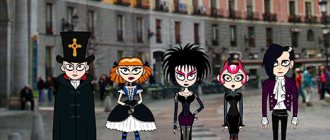| Kind of work: | Essay |
| Date added: | 21.01.2020 |
- This type of work is not a scientific work, it is not a finished final qualifying work!
- This type of work is a finished result of processing, structuring and formatting collected information intended for use as a source of material for independent preparation of educational work.
If you have a hard time understanding this topic, write to me on WhatsApp, we’ll look into your topic, agree on a deadline, and I’ll help you!
If you want to learn how to correctly carry out and write abstracts on any subject, then on the page “what is an abstract and how to do it” I wrote in detail.
Introduction
Youth subcultures play a dominant role in the sociology of youth and have been the object of research by scientists since the 60s of the last century. Of course, subcultures such as goths, punks, hippies, etc. came to us from the West and America (hippies were especially common there), since there were no subcultures born in Russia. Perhaps this is due to the Iron Curtain that existed at that time. Russian researchers and analysts were even afraid to use such a term as “subculture”, but used the definition “informal people”. Z.V. Sikevich wrote that the youth subculture is understood as “the culture of a certain young generation with a common way of life, behavior, group norms, values and stereotypes.” I cannot agree with the author that the subculture belongs to a certain generation, but I believe that various informal associations belong to certain groups of society. Although it can be noted that some cultures are passed on from generation to generation and have been developing for more than a century. For me, subculture is a way of self-expression for young people, a so-called attempt at self-expression; sometimes it can be very strange, but the worst thing is that it ends in sad consequences. Some subcultures go away, others replace them, but they always were, are and always will be. Attitudes towards them will always be different, everything will depend on the message that culture brings, so this topic is all relevant. At a certain period in my life, I myself belonged to a certain subculture, so this topic is the most suitable for me.
Bibliography
- Belyaev, A. A. Belyaev. - M.: INFRARED, 2012. — — 399 p.
- Golden two, G.G. Ten subcultures / G.G. Golden two. — — M., 2013. — 58 p.
- Golden two, G.G. Subcultures / G.G. Golden two. - M.: Poster, 2014. - 21-23 p.
- Kravchenko A. I. Culturology / A. I. Kravchenko. — M.: Academic project, 2013 — — 537 p.
- Levikov, S.I. Jugendsubkultur / SI Levikova. — M.: FEVERPRESS, 2012. — — 315 p.
- Omelchenko E. Youth cultures and subcultures / E. Omelchenko. - M.: Institute of Sociology RAS, 2013. - - 262 p.
- Gritsanov A. A. Encyclopedia of Sociology. — M.: House of Books, 2014 — — 131 p.
The history of the emergence of youth subcultures
There is no exact date of birth of the subculture. Of course, it is impossible to find out whether informal associations existed, for example, in the time of Ivan the Terrible, but I think that in the time of Peter I they were already beginning to arise. Unfortunately, there is no exact answer to this question, but if we consider the existing subcultures of the last century, the very first of them were the “hippies” of the 60s. But one of the informal ones that appeared a decade earlier was the so-called “stealing”. The brightly dressed people, who spoke their own language, were a little cynical and denied some moral standards.
To understand their essence, just watch the domestically produced film “Hipsters.” But under pressure from the authorities, this culture ceased to exist. The next stage of development was the 70-90s. Such representatives of informal youth as punks, metallurgists, goths, alternatives and others appeared. Some take drugs, listen to rock and reject all the norms of society, others live in “their own world”, walk through cemeteries and perform rituals.
But ordinary people, still clinging to them, do not understand why they need these mohawks on their heads, black clothes, crosses, pierced ears and other distinctive signs. Another stage was the period of the early 2000s. Then emo, major, extremes, hackers, parkourists and many other cultures common to the whole world begin to appear. As mentioned above, all these cultures came to Russia from abroad.
Features of participation
The process of a young person’s involvement in the life of a subculture is implemented in 4 stages.
Self-determination within a subculture (personal identity)
The first stage is characterized by the destruction of previous values, attitudes and the adoption of the lifestyle and morality of a given subculture, a look at reality through the prism of the values and ideas prescribed in a particular group.
Group affiliation (“we”, “ours”, “ours”)
At this level, members of the subculture:
- exchange information about concerts, performers, music;
- share their impressions of books and song lyrics;
- they tell their first or new experience in trying drugs or other substances, as well as the experience of antisocial behavior, that is, a community of participants is cultivated.
Changes in appearance and leisure time
At the next stage, a person finds himself at some meetings and parties of all representatives of the informal movements of the city. Most often through friends. In these places:
- new acquaintances arise;
- the sense of community, agency and meaning is further enhanced.
At the same time, external changes in a person and changes in usual leisure time occur. Many subcultures require specific external changes. Sometimes these changes contradict the requirements of family or work, but if a person is very interested in a subculture, he will give preference to it.
A complete change in life and escape from reality
The fourth stage represents the transition of a subculture from a person’s hobby to everyday life and reality. Subcultural principles and norms permeate a person’s entire life. Often he gives up his name and chooses a pseudonym for virtual communication or a nickname for communicating at real parties.
At this same stage, disagreements may arise with peers, acquaintances from “pre-subcultural” life and relatives. Most often they are caused by a discrepancy in opinions and views regarding the ideology of a particular subculture. For example, if we are talking about a musical subculture, then there are different views on musical style. Sometimes it all ends:
- the departure of a subculture member from home;
- vagrancy;
- begging;
- wandering around friends or hangouts;
- leaving for “their own”.
Functions and factors of uniting subcultures
Simply put, a subculture is a part of a social culture that is different from the one that exists in society at a given stage of development. It unites all young people who have certain distinctive characteristics and believe in certain ideals.
In my opinion, the main function of a subculture is the ability of young people to stand out among the crowd, understand themselves and their time, and find friends on the same wavelength. Another question is that the subculture does not always have a positive effect on the younger generation. Other researchers highlight such a function as emancipation - increasing status and leaving parental control. Usually it is accompanied by conflicts with parents and goes into a phase of exaggerated rejection of the norms of behavior of both the child and the adult. This creates conditions for teenagers to develop their own subcultures.
In order for a subculture to be successful throughout the world, certain unifying factors are necessary:
- Common activity, the organization of joint activities makes it logical to unite people.
- Music, the coincidence of musical tastes, has been a powerful unifying factor for centuries and has served to form many subcultures.
- Distinctive features, signs or elements of clothing.
- A specific idol to be worshiped, be it a famous person, a mythical character, a life goal, or something else.
Each group of a certain subculture has its own special world of values, its own norms, slang, some subcultures even have their own rituals and rituals. I.P. Bashkatov believes that “it is not the perverted natural needs of adolescents for fashionable clothes, sexual pleasures, prestigious things, alcohol and drugs, etc., but the social need for communication, self-affirmation, prestige, and the desire to improve their lives that push them to communicate with other people " And such people are neither parents, nor teachers, nor even “normal” peers, nor “outcasts” who spontaneously united in informal groups.” In this I fully support the author. If a teenager listens to rock music and everyone around him prefers classical music, what should he do? Of course, go against the system and look for your own kind. And if we consider such a subculture as emo, then the poor people who have failed in life and are thinking about suicide? Who do they talk about this with, not their parents? It is very sad when parents do not notice the child’s condition, but he still does what he intended.
Reasons for being interested in subculture
Not all young people are interested in subcultures. Interest in them often arises under a certain situation (psychosocial state) in a person’s life.
- Lack of full traditional socialization (for example, dysfunctional relationships with parents and/or peers).
- Sudden changes in the usual way of life (divorce of parents, death of someone close, family relocation, change in status or financial situation).
- Often infantile youth become participants in youth subcultures. For them, the philosophy of a subculture, its values and way of life become salvation, an escape from reality, a refuge. Most of today's youth do not want to grow up and become adults on a social level; they are afraid of responsibility, routine, and responsibilities.
- Representatives of informal groups want to appear adults, but live an easy and carefree life. Most often, the solution is to use any substances (drugs, alcohol) or copy external behavior.
Now our society is once again experiencing serious changes, revaluation of values, destruction and creation of many systems, so it is the youth who find it most difficult. Although this is the most mobile demographic group, at the same time it is the most socially weak and unstable group:
- on the one hand, young people want to understand society, enter it, find guidelines and their place;
- and on the other hand, one encounters misunderstanding and non-acceptance, the absence of those same guidelines, contradictory information data, the influence of different philosophies and visions of the world.
Types of subcultures and their main features
The gender composition of youth subcultures differs; while in some cultures aggression and physical strength are encouraged (skinheads, sports fans), the number of men predominates. If the subculture is calmer, then both women and men prevail on equal terms. There are hundreds of subcultures in their history, let's look at the most basic of them:
- Hippies are one of the oldest subcultures. It was against violence, against routine. They were supporters of free love and free living. They could leave home without money, food and simply travel the world because their main message was “We are for world peace”, of course, as you can already understand, they were against the war “Macedonian, not war” ( make love, not war). The distinctive features of hippies were long hair with ribbons woven into it (and it didn’t matter whether it was a man or a woman), clothes in soft colors and natural fabrics, all kinds of bracelets, hair dryers and other “handmade crafts.” An ever-peaceful, beaming face was also a hallmark of this subculture (some scholars have argued that this is due to the fact that hippies were often seen using drugs and alcohol). Hippies often gathered by the sea, ocean or river to make fires, sing songs and play the guitar. The most important distinctive feature, which was indicated everywhere: on houses, cars, clothes and special badges (attached to clothes) was the pacifist - an international symbol of peace.
- “Punks” - originated in the 60s and 70s of the last century in England and Canada. They did not believe in the future, they strived for personal freedom and complete independence, and to some extent there were anarchic traits. Supporters of alcohol, drugs, fights and various uprisings. Their clothing was dominated by dark colors, ripped jeans, chunky shoes, chains, skulls and spikes. Punk hair was dyed in bright acid colors, and one of the popular hairstyles was the mohawk. They listened mainly to heavy music, namely rock and punk rock. The younger brothers of punk were the so-called metalheads and alternatives, who were distinguished by a calm character, lack of aggression, the main similarity was the music and style of clothing.
- “Emo” is a fairly young subculture that first appeared in America in the 80s. But its heyday came at the beginning of the 2000s. Depressives who often think about death believe that their life is doomed and they cannot achieve anything. They think about suicide because they feel worthless and see no point in continuing to live. But sometimes, standing on the edge of a roof or holding a razor in their hands, something stops them and they cannot finish what they started. They often suffer from anorexia, and sometimes it is difficult to distinguish a guy from a girl. They wear long bangs dyed pink. Dressed in a variety of colorful T-shirts, tight jeans and sneakers, they always carry a bag over their shoulder. They listen to emo rock, which also sings about suicide. Almost all other subcultures simply hate emo and mock them in every sense, and the more aggressively they even fight them. emo rock. At a certain period of my life, I myself belonged to this subculture; of course, I didn’t cut my wrists, I didn’t stand on the edge of the roof and didn’t think, but I found it in a depressed state. I liked their clothing style, music and state of mind, but it didn’t last long, so it can be attributed to the so-called youthful maximalism and desire for something new.
- “Goths” appeared in the late 70s in England. Representatives of the subculture are melancholic, depressed, and death is a fetish for them. True aesthetes. The predominant color in clothing is black, sometimes massive red shoes are added, girls love to wear fluffy skirts and corsets. Makeup and a pale face are required; as a rule, everything is painted. They love to walk through cemeteries and think about life there. Crazy romantics often deny all traditions and norms. Sometimes many people believe that the Goths make sacrifices and perform rituals, but this is not so; most likely, they are confused with “Satanists” because they are very similar.
There are many other subcultures such as skinheads, anime, hipsters (younger brothers of the hippies), freaks, role models and others. But these subcultures are dominant in certain areas and have not yet completely taken over the world. The most popular countries with youth subcultures are America and Japan. There are a huge number of different informal associations and their different subtypes, and from these countries, thanks to the Internet, they are spreading throughout the world.
Development of the subculture phenomenon in Russia
Youth subcultures first emerged in the West (the first half of the 20th century), and the term “subculture” itself appeared in the 30s of the 20th century. This phenomenon came to Russia in the late 40s.
Some of the subcultures that currently exist in Russia (hipsters, majors) originate in the Soviet Union. In the USSR, the definition “Informal youth associations” was used to designate youth subcultures. This is where the slang term “informals” came from.
The emergence and development of subcultures is always preceded by:
- any changes in the spheres (or one of its spheres) of society (economic, political, social and others);
- psychophysiological characteristics of young people;
- features of mentality;
- lack of socially significant activities in the lives of young people, and more.
Often a subculture serves as a way to protect oneself, protect oneself, and escape reality.
The history of the emergence and development of youth subcultures in Russia can be divided into several stages (waves).
First stage (40-60s of the XX century)
It began with the emergence of subcultures in Russia. The most popular subcultures were those of an active, creative, romantic nature (bards), and musical orientation. There were practically no protest and negative subcultures then. This is due to the availability of leisure centers, interest clubs, cultural institutions, as well as positive education in schools and censorship (screening out protest and negative material). In those years, the entire society was under the strict attention of the Komsomol. Western music and other trends of Western life were almost inaccessible, and therefore the possibility of creating subcultural clubs that would not obey the Komsomol was minimized.
- But it was precisely during this period and precisely this musical gap that created the first Soviet subculture - the dude (late 40s). In the early 1960s, interest in dudes disappeared: representatives of this movement grew, and many elements of Western culture became easily accessible and legal.
- In place of the dudes, Beatlemania (60s) captured youth society even more en masse. It was a general craze for rock and roll and one of the bands performing it.
The first surge of subcultures (40-60s) was distinguished by its lightness and superficiality. Hipsters and Beatlemania became the first manifestations of nonconformism and counterculture. These were partly informal subcultures, and partly youth movements based on a passion for dancing, music, and a bright and eye-catching (but not shocking) appearance.
The second stage of the development of youth subcultures (late 60s - early 80s)
The deepest, broadest, most powerful and lasting surge of counterculture. In Russia at that moment there was a period of stagnation.
- In the second half of the 60s of the 20th century, the freak movement arose in Russia. This culture came to us from North America. Its first manifestation was noticeable among hippies. In the 70s, the freak subculture reached its apogee and began to manifest itself in the external features of its representatives (piercings, tattoos, provocative clothing, hairstyles). This trend has continued to this day.
- In the late 1970s, a youth subculture of majors emerged. Nowadays, this subculture also exists, only the name has changed a little. Now it sounds like “golden youth”. This subculture is considered the antipode of gopniks and “cattle”.
- The main countercultural movement of this period was the “System” (70s). System components changed periodically.
- But it all started with hippies. Hippie culture came from the USA (1960-1970). In the USSR, this movement arose only in the 1970s, while in the USA it was already dying down. There were not as many hippies in the USSR as in the West. Society's attitude towards representatives of this subculture was predominantly negative. However, this did not prevent the hippie subculture from existing in the USSR in the 1970-1990s. In our time, echoes of this culture remain. But it would be more relevant to call her a “cyber hippie.” The emphasis from real meetings of like-minded people was transferred to virtual communication and virtual communities. Only mass, pre-organized meetings remained real. The most popular among such meetings now in Russia are “Rainbow” (1990 – today), the annual hippie meetings in Moscow on April 1 “at Gogol” and June 1 in Tsaritsyn Park. Echoes of hippie culture can be found today in other subcultures. The symbolism and culture of hippies became the source of most other domestic subcultures.
The period of perestroika and the collapse of the USSR (80s - early 90s)
This period was a real explosion of nonconformism. Youth subcultures began to emerge, transform, and develop more actively.
- The “system” was divided into numerous separate movements: metalheads (who later divided into moderate and rabid), bikers, nostalgists, Afghans, optimists, pacifists, hairies, punks, rockers, businessmen, respectables, gopniks, wide-pants, jocks, businessmen, hustlers, street and others. Crime and addiction to psychoactive substances are beginning to penetrate into the youth subculture.
- Society for the first time recognized youth subcultures as a social problem and began to publicize it (mass media, scientific literature).
- In the 80s of the 20th century, football fans first appeared in the USSR. Sometimes the praise of a favorite team reached the point of fanaticism and fights broke out between fans of different football clubs, which were stopped by the police. Now football fanaticism is a very pressing problem in our society. It is worth noting that for people who do not consider themselves involved in football and are far from this sport and any teams, fan groups are completely harmless. Whereas for each other, fans of different teams are a real threat. Sometimes they specially organize so-called “wall to wall” meetings, or fights are spontaneous. An additional danger is that football fanatics are often Nazis. Often such people adhere to right-wing radical views, nationalism and racism.
- In 1984, the first experiments with rap arose in Russia (among African Americans and Latin Americans in the 70s). But the hip-hop movement gained its greatest popularity in Russia in the second half of the 1980s, together with the breakdancing movement. This direction was finally formed in Russia only in the 1990s.
- A little later, towards the end of the 80s, society was struck by a new subculture. We are talking about neo-fascist youth groups. But no one gave official information about this subculture, and in general they tried not to publicize their activities. This disregard led to the creation of the National Front party by activists of this movement. The main symbol of this culture is the swastika. They openly called for adherence to National Socialist ideology. This is how the representatives of this subculture believed that the Russian nation would survive. First of all, they found a solution in the sterilization of inferior (in their opinion) nations, the eviction of “blacks” and other nationalities. The principle of this party was “cruelty is an innate quality of man.” Then echoes of this were expressed in such subcultures as fascists and skinheads.
- At the end of the 80s, another direction of culture came to Russia. The so-called Tolkienists, who originated in America and Europe in the mid-60s. This trend gained widespread popularity in our country only in the first decade of the 21st century. The impetus for the emergence of this subculture was the publication of The Lord of the Ring.
- In our time, thanks to the Tolkienist movement, other subcultures are emerging. For example, neopagans. Representatives of Tolkien culture, having matured, often go into paganism. Such cultures contribute to the revival of the spirit of Ancient Rus', the traditions of our people, ancient values, and so on.
Post-Soviet period of development of subcultures (90s - early 2000s)
Youth movements began to receive even more publicity in the media, spread throughout all regions of the country, take root, borrow, and integrate. Subcultures are acquiring an even more freewheeling, criminogenic character; drugs, alcohol and other substances are taking root among young people. Previously existing subcultures continue their activities and new ones emerge.
- In the early 90s, the anime craze reached Russia. It originated in Japan in the 70-80s. From the moment it appeared in Russia, it began to actively develop, gain popularity and audience. This subculture has survived to this day. Moreover, it continues to captivate new generations of youth and develop.
- In the mid-90s, breakdancing and graffiti became popular in Russia. Our passion for graffiti came from New York. In fact, breakdancing and graffiti are part of hip-hop culture. Along with these areas, parkour and skateboarding also began to develop. The peak of popularity of the parkour hobby came in 2006, this was associated with the release of the film “District 13”. At different periods, skateboarding was part of one or another culture. For a long time it was an attribute of punk culture. But later skating began to emerge as an independent subculture. And today this is a completely different independent movement, which has its own characteristics, principles, goals, attributes, symbols and meaning.
Modern Russia (2000s – today)
Since 2000, the phenomenon of youth subcultures has begun to be actively studied by science (pedagogy, psychology, sociology and others). An alternative vision of the world of modern subcultures is more manifested in appearance, slang and is of an entertaining nature than the meaning of life.
- Nonconformism has become less ardent, although back in 2007 some movements (skinheads, goths, emo) made themselves known very loudly.
- For modern Russia, biker societies, the subculture of Internet communities, gopniks, rappers or hip-hoppers, role players, punks, metalheads, football fans, goths, skinheads, hippies and others are relevant. Today's subcultures are distinguished by their diversity.
- Along with technological progress and the development of society, subcultures have changed noticeably. For example, the hacker movement has revived with renewed vigor. They first started talking about it in the late 50s in the USA. The movement of that time had absolutely no destructive or negative character. On the contrary, it was built on the principles of innovation, creativity, improvement and mutual assistance.
- In the 70s, a term arose called phreakers - hackers who hack telephone networks. In the early 80s, interest in telephones disappeared and interest in computers and other equipment appeared. Since those same years, the direction and nature of the hacker subculture began to change. He became more and more destructive, illegal, and aggressive. Hackers developed viruses and introduced them, stole passwords, card numbers, personal data, hacked websites and changed or blocked any information.
- In the 90s, a trend began to be observed of hackers interacting with criminal communities and terrorist organizations. The latter served to introduce the terms “cyberterrorism”, “cyber espionage”, “cyber crime”. Nowadays, the hacker subculture attracts a lot of attention from the state. This is a truly strong and dangerous subculture. Of course, it has its advantages, but at the same time it seriously influences the life of society.
- New movements are emerging. For example, vapers. The basis for their emergence was the ban on smoking in public places and the emergence of electronic cigarettes. Representatives of this subculture have their own slang, motto, and they organize meetings (“gatherings”). They do not have values or attitudes as such. This subculture is exclusively entertaining in nature and has only external manifestations. However, it causes negativity from some members of society.
The influence of subcultures on society
It is impossible to give an exact answer to the question of whether a subculture has a good or bad influence on society and youth in particular. As the saying goes: “Everything is good in moderation.” During the period of growing up, teenagers try to find themselves and understand what they want from life, so they begin to use different forms of subcultures, the main thing is to finish with this and not miss the moment of growing up.
But the problem is that many subcultures do not encourage career building, personal development, family and children. Everywhere there is only hopelessness, aggression, alcohol and denial of all norms, and such positions are fraught with consequences.
On the one hand, young people belonging to subcultures have constant communication and are passionate about what interests them. It also contributes to the socialization of young people, helps them realize their desires and raise their authority in the eyes of their comrades.
On the other hand, everything depends on the subculture itself and the person. There are certain cultures that call for violence, cruelty to animals, people here are certainly dangerous to society and should be feared. If there is a head on his shoulders, then a teenager will never try drugs, jump off a roof or commit a crime. Although it is better for parents to simply let their child play sports, go out and study, sometimes it is useful to join some kind of society to begin to build his character. To understand the influence of a subculture on teenagers, it is necessary to understand the meaning of their existence.
After all, various youth movements arise from certain trends in society. Aggression in subcultures becomes a reaction to adult injustice, military conflicts and improper upbringing, and a bright appearance indicates a rebellion against norms. Therefore, parents should understand their children and give them some freedom. Teenagers tend to outgrow their hobbies. In this case, the influence of subcultures gradually weakens and over time the child understands that he does not need it at all. You can turn to this or that subculture, the main thing is without fanaticism.
The essence of the term
Subculture
is a concept derived from the Latin words “sub” (under) and “cultura” (culture), and is used in sociology and cultural studies. We are talking about a part of society that differs from the overwhelming majority in its worldview and behavior. Carriers of subcultures may differ from other people in their value system, appearance and other aspects.
Youth subcultures have several varieties and are formed on demographic, national, geographical, professional and other bases.
Most often, one or another subculture “marks” its adherents with certain patterns of behavior, features of appearance (clothing, hairstyles), vocabulary and other distinctive characteristics.
Youth as a socio-psychological group
To consider the problems of youth, it is necessary to imagine what youth is and how it differs from other social groups.
Therefore, the first chapter is devoted to the analysis of individual and personal characteristics characteristic of young people, as well as patterns of assimilation of norms, values, behavior characteristic of society, various organized and unorganized groups that influence the individual.
For a long time in Russian sociology, adolescents were not considered as a separate socio-demographic group.
The identification of such a group did not fit into existing ideas about the class structure of society and contradicted the official ideological doctrine of its socio-political unity.
One of the first definitions of the term “youth” was given by V.T. Lisovsky in 1968: “the younger generation of people who are going through the stage of socialization and learning (and have already learned in older age) educational, professional, cultural and other social functions; depending on specific historical conditions, age criteria for youth can vary from 16 to 30 years.” A more complete definition was given later by I.S. Kon: “Youth is a socio-demographic group characterized by a set of age characteristics, characteristics of social status and socio-psychological characteristics determined by both.” Youth as a specific stage, a stage of the life cycle, is biologically universal, but its specific age framework, associated social status and socio-psychological characteristics are social and historical in nature and depend on the social system, culture and patterns of socialization inherent in society.”
Today, scientists define youth as a socio-demographic group of society, characterized by a number of features, characteristics of social status and determined by certain socio-psychological characteristics determined by the level of socio-economic, cultural development, and characteristics of socialization in Russian society.
Youth is the path to the future that a person chooses himself. Choosing the future and planning it is a characteristic feature of young age; it would not be so attractive if a person knew in advance what would happen to him tomorrow, in a month, in a year.
In the psychology of old age, youth is characterized as a period of formation of a stable system of values, the formation of self-awareness and the formation of a person’s social status. The consciousness of a young person has a special sensitivity, the ability to process and assimilate a huge flow of information. At this time, critical thinking develops, the desire to make one’s own assessment of various phenomena, the search for arguments, and original thinking. At the same time, at this age there are still some attitudes and stereotypes inherited from the previous generation. This is due to the fact that the period of active activity confronts the young man with the limited nature of practical, creative activity, and the incomplete inclusion of the young man in the system of social relations. Therefore, in the behavior of young people there is an amazing combination of contradictory qualities and characteristics: the desire for identification and isolation, conformism and negativism, imitation and rejection of generally accepted norms, the desire for communication and isolation, isolation from the outside world. The instability and inconsistency of youthful consciousness affects many forms of behavior and activity of the individual. The consciousness of young people is determined by a number of objective circumstances.
Firstly, in modern conditions the process of socialization has become more complex and lengthy, and, accordingly, the criteria for social maturity have become different. They are determined not only by entering into an independent working life, but also by obtaining an education, training in a profession, real political and civil rights, and material independence from parents. The influence of these factors is not simultaneous and unambiguous in different social groups, therefore, a teenager’s assimilation of the system of social roles of adults is contradictory. He can be responsible and serious in one area and feel like a teenager in another.
Secondly, the formation of social maturity of young people occurs under the influence of many relatively independent factors: Family, school, work collective, media, youth organizations and spontaneous groups. This multiplicity of institutions and mechanisms of socialization is not a rigid hierarchical system; each of them performs its own specific functions in the development of the individual.
Youth is the time when everyone must determine their own destiny, find the only true path of life leading to success, which will allow them to realize their abilities and talents to the maximum. This period is associated with a painfully difficult process of self-knowledge, finding one’s “I”. A person must determine the limits of his actual abilities in order to understand what he is capable of in order to declare himself in society. On the other hand, at the same time, he must form the most accurate picture of the world around him, systematize its value orientations, political, moral, aesthetic views. Life gives a young person the need to make a number of critical decisions in the absence of life experience. Choosing a profession, choosing a partner, choosing friends - this is not a complete list of problems, certain decisions that largely shape the future way of life.











